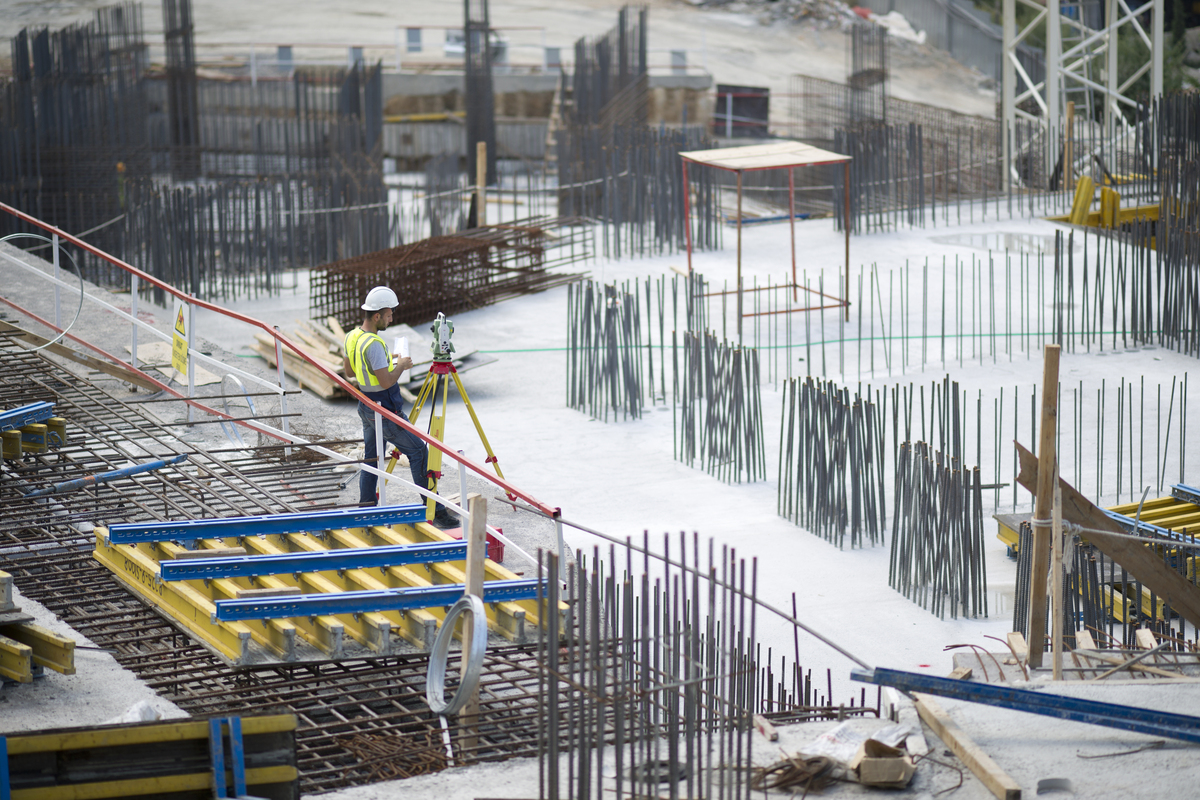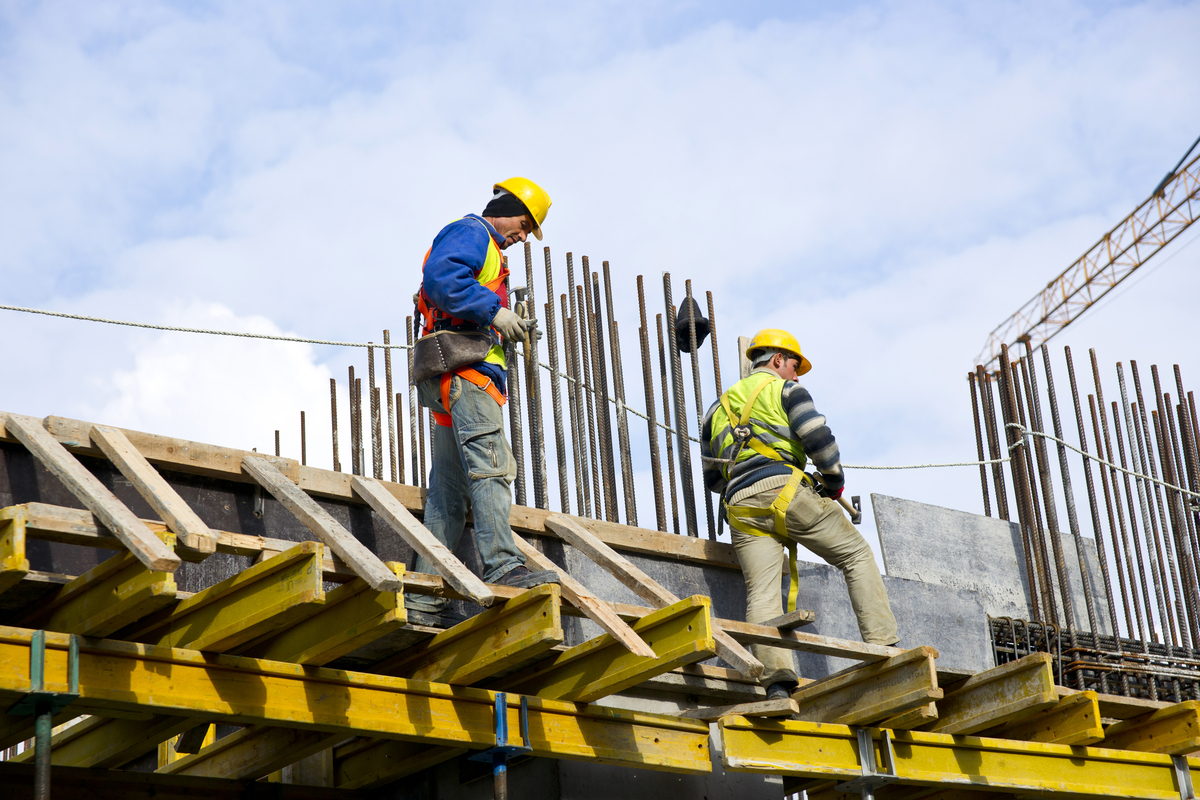Exclusive Neuroject Article: Blockchain technology is poised to transform the entire foundation of the construction sector, which is on the verge of a technological revolution. The use of blockchain in construction holds enormous promise for revolutionizing the way construction projects are planned, carried out, and controlled.
Blockchain in construction has the ability to transform supply chain management, automate contract execution, guarantee document authenticity, and promote effective stakeholder engagement because of its decentralized and transparent nature.
Table of Contents
Introduction to Blockchain in Construction
Few technological advancements have generated as much curiosity and have the potential to revolutionize society as blockchain. Blockchain in construction, which was initially developed to support cryptocurrencies, has transcended its intended use and found use in a variety of industries, offering increased transparency, improved security, and simplified procedures.
The construction industry is primed for a technological disruption that can solve its long-standing problems due to its dense stakeholder network, complicated supplier networks, and massive data flow. As 2023 approaches, project management, data sharing, and cooperation might all be revolutionized by incorporating blockchain into the construction industry.
At its foundation, blockchain in construction is a decentralized, impenetrable digital ledger system that uses cryptographic hashing and consensus methods to guarantee the accuracy and immutability of records. Blockchain develops trust among its users and eliminates the need for middlemen by sharing data across a network of users. These characteristics have a substantial positive impact on the construction business, which is characterized by fragmented data silos, paper-intensive operations, and the possibility of disputes.
The junction between blockchain and construction in 2023 is thoroughly covered in this article. We will examine the various ways that blockchain technology is being used in the building industry, from quality control and supply chain management to document verification and project collaboration. We will explore the concrete effects of blockchain on boosting transparency, efficiency, and security inside construction projects, drawing conclusions from real-world deployments and industry case studies.
It’s crucial to recognize the current difficulties and factors in order to properly analyze the potential benefits of implementing blockchain in construction. The challenges that require careful investigation include integrating blockchain into established operations, assuring compliance with legal requirements, and addressing issues with scalability and energy efficiency. We seek to offer a comprehensive viewpoint on the use of blockchain in construction by conducting a balanced analysis of both prospects and challenges.

Understanding Blockchain Technology
Due to its disruptive potential, blockchain technology, the foundation of decentralized digital networks, has attracted significant attention across industries. A blockchain in construction is fundamentally a distributed, unchangeable digital ledger that securely and openly records transactions and other data. Its architecture is made up of a number of essential elements that work together to guarantee the reliability and integrity of the data that is stored.
“Blocks” are the fundamental units that make up a blockchain in construction. These blocks consist of a collection of transactions or data items that are cryptographically hashed to produce a block-specific identifier. These identifiers are essential for maintaining data integrity as well as block organization. A chain of blocks is effectively formed by each block including a reference to the hash of the block before it, hence the name “blockchain.” Because of this chaining method, it is very difficult to change any information included within a block without also changing the hash of all subsequent blocks, which is almost impossible in a decentralized network.
Blockchain technology’s defining feature is decentralization. The network employs a distributed consensus architecture in place of a centralized authority. This indicates that a network of participants, or “nodes,” validate and log transactions using a consensus algorithm like proof-of-work (PoW) or proof-of-stake (PoS). By enhancing security and resilience, this decentralized validation mechanism makes it extremely challenging for bad actors to breach the system.
Self-executing contracts with established rules and circumstances are known as smart contracts, another essential component of blockchain in construction. When certain circumstances are met, these contracts are automatically implemented, doing away with the need for middlemen and expediting several procedures.
Security is another important aspect of blockchain technology. It is very challenging for hackers to tamper with the data kept on the blockchain because of the decentralized architecture of the network and the usage of cryptographic algorithms. Furthermore, the network is very resistant to fraud and criminal activity since consensus procedures are used to verify that everyone using it agrees on the authenticity of transactions.
Blockchain is a revolutionary technology that offers secure, open, and decentralized solutions for a range of industries. It is a potent instrument for transforming industries like finance, supply chain, healthcare, and more because of its capacity to produce tamper-proof documents and establish confidence among participants. The potential of blockchain to revolutionize how we maintain data and perform transactions is limitless as it continues to develop.
Blockchain Applications in Construction
Construction is one of several industries that blockchain technology has the potential to disrupt. With its built-in attributes of transparency, security, and decentralization, blockchain can help the construction industry overcome significant obstacles, increase productivity, and simplify procedures.
We will examine various uses of blockchain in the construction industry in this article, including supply chain management, transparency and traceability, supplier management, quality control, and certification, smart contracts and automation, streamlined payment processes, immutable contract execution, dispute resolution, and arbitration, document management and authentication, secure sharing and storage, digital signatures and timestamps, anti-fraud measures, project management, and more.
Supply Chain Management
By offering a transparent and secure platform for tracking the movement of products and resources, blockchain can improve supply chain management in the construction industry. The blockchain can be used to record every transaction and movement of products, allowing participants to track the origin, location, and status of items in real-time.
By lowering supply chain delays and errors, this openness lowers the danger of products becoming counterfeit, guarantees compliance with laws and standards, and increases efficiency.
Transparency and Traceability: Throughout the construction process, transparency and traceability are made possible via distributed ledger technology on the blockchain. As a result of the blockchain’s ability to record every transaction, alteration, and update and make them accessible to authorized users, there is less room for fraud and manipulation. This openness increases stakeholder trust, settles disagreements, and makes decision-making more efficient.
Supplier Management: By building a decentralized database of suppliers’ data, including credentials, certificates, and performance histories, blockchain can simplify supplier management. This makes it possible for construction organizations to check the legitimacy of suppliers, assess their qualifications, and determine the best course of action for procurement. Blockchain can also automate supplier payments, assuring secure and timely transactions.
Quality Control and Certification: By offering a visible and unchangeable record of inspections, testing, and certifications, blockchain technology can improve quality control and certification procedures in the construction industry.
The blockchain can securely record all pertinent data, including test results, compliance documentation, and the materials utilized. This guarantees that quality requirements are met, makes auditing procedures simpler, and improves the general quality and safety of the project.
Smart Contracts and Automation
Smart contracts, which are autonomous contracts with set terms, can be implemented thanks to blockchain technology. Numerous building activities, including project milestones, payment schedules, and delivery confirmations, can be automated using smart contracts. Smart contracts boost efficiency by doing away with the need for middlemen and manual processing, which lowers costs, delays, and costs associated with project execution.
Streamlined Payment Processes: By facilitating direct and secure peer-to-peer payments, blockchain-based payment systems can simplify financial transactions in the construction industry. Blockchain improves the speed and efficiency of payment operations by doing away with middlemen and cutting transaction costs. Additionally, it promotes openness, lowers the possibility of fraud or legal issues, and helps both contractors and subcontractors.
Immutable Contract Execution: A contract cannot be changed or tampered with once it is stored on the blockchain thanks to the immutability of the technology. This feature offers a trustworthy and transparent record of contractual agreements, lowering the possibility of conflicts and giving parties to disagreements a verifiable source of the truth. Effective contract management and auditing are also made possible by immutable contract execution.
Dispute Resolution and Arbitration: By supplying an auditable and tamper-proof record of all pertinent information, blockchain technology can facilitate arbitration and conflict resolution in the construction industry. The blockchain can preserve evidence, contracts, and communication logs in case of disputes, enabling quicker and more precise resolution procedures. Fairness and trust among the parties concerned are encouraged by this transparency.

Document Management and Authentication
For organizing construction-related documents including licenses, contracts, and drawings, blockchain offers a safe and decentralized platform. Construction companies may guarantee papers’ integrity, stop unauthorized changes, and make information sharing and retrieval easier by storing documents on the blockchain. Document validity may be quickly verified thanks to the blockchain’s authentication features.
Secure Sharing and Storage: For critical construction data, blockchain offers a safe and decentralized storage solution. Blockchain disperses data among numerous nodes, making it highly resistant to illegal access or manipulation, as opposed to depending on centralized systems, which are prone to hacking and data breaches. The system for safe data transfer and storage improves privacy and security.
Digital Signatures and Timestamps: Digital signatures and timestamps, which offer unquestionable evidence of a document’s integrity and authenticity, are made possible by blockchain technology. Timestamps offer a verifiable record of when a document was created or modified, while digital signatures ensure that papers cannot be altered without being noticed. These characteristics improve the legitimacy and conformity with the law of construction-related documents.
Anti-Fraud Measures: The transparency and immutability of blockchain serve as effective barriers against fraud in the building sector. The blockchain keeps track of every transaction and modification, making it more difficult for bad actors to modify data or carry out fraudulent activities. This increases stakeholder trust while lowering the financial and reputational risks related to fraud.
Project Management and Collaboration
By offering a decentralized platform for project information sharing, tracking progress, and activity coordination, blockchain technology can enhance project management and collaboration in the construction industry. It enables real-time interaction, information exchange, and decision-making among project stakeholders, resulting in increased effectiveness and coordination over the course of the project.
Enhanced Project Tracking: Project milestones, tasks, and resources may be accurately tracked because of the blockchain’s transparency and audibility. Project managers may track progress, spot bottlenecks, and maximize resource allocation by storing this data on the blockchain. Better project control, on-time delivery, and increased overall performance are all results of this improved project tracking.
Collaboration and Communication: Architects, engineers, contractors, and clients may communicate securely and easily thanks to blockchain-based collaboration tools. Blockchain improves cooperation, minimizes communication gaps, and promotes effective decision-making by offering a shared workspace for information exchange, discussing design changes, and problem-solving.
Resource Allocation and Optimization: By offering a transparent and decentralized platform for tracking and managing resources including machinery, materials, and labor, blockchain can improve resource allocation in the construction industry. Construction organizations may optimize resource allocation, cut waste, and improve project efficiency by properly tracking resource usage and availability on the blockchain.
Blockchain technology has a wide range of uses that have the potential to revolutionize the construction sector. Blockchain’s decentralization, transparency, and security features show enormous promise for fostering innovation, efficiency, and cooperation in building projects, from strengthening supply chain management and transparency to speeding payment procedures and improving project management.
The construction sector can overcome long-standing obstacles, boost production, and complete projects more successfully in the digital era by embracing blockchain.

Implementing Blockchain in Construction
The Blockchain technology used in the construction sector has enormous potential to revolutionize procedures, improve transparency, and foster better collaboration. To achieve successful adoption, a number of obstacles and factors must be taken into account.
This section will examine the main obstacles and factors to be taken into account when integrating blockchain in the construction industry, followed by the procedures to take in order to do so successfully. Furthermore, real-world case studies highlighting successful implementations, lessons gained, and the prospects for blockchain in the construction industry will be discussed.
Challenges and Considerations
Technological Infrastructure: Blockchain implementation in the building industry needs a strong technological foundation that can support the dispersed nature of the technology. The construction businesses must make sure they have the requisite hardware, network capabilities, and technical know-how to manage the demands of blockchain implementation. The current IT systems may need to be modified or merged with blockchain platforms.
Data Privacy and Security: Given that the construction business deals with sensitive information and intellectual property, data privacy and security are major issues. Blockchain technology enhances security through encryption and decentralization, but businesses must still take into account the privacy implications and make sure they are in compliance with all applicable laws. To protect sensitive information, proper access controls and encryption techniques must be used.
Industry-wide Collaboration: Collaboration and cooperation among a variety of stakeholders, including contractors, subcontractors, suppliers, architects, engineers, and regulatory agencies, are necessary for the successful deployment of blockchain in the construction industry. To enable smooth data sharing and interoperability across the construction ecosystem, it is essential to establish industry-wide standards, protocols, and governance structures.
Steps to Implement Blockchain
1. Identifying Use Cases: Finding appropriate use cases within the construction sector is the first step in integrating blockchain. This entails identifying areas of inefficiency, pain points, and potential benefits from blockchain’s transparency, traceability, and automation features. Supply chain management, payment processing, contract administration, and document verification are just a few examples of use cases.
2. Selecting the Right Blockchain Platform: Making the right blockchain platform selection is essential for deployment success. Scalability, security components, consensus processes, interoperability, and community support are all important considerations. Depending on the unique requirements of the construction project, public blockchains like Ethereum and Hyperledger Fabric are attractive options for private or consortium blockchains.
3. Building a Consortium or Private Blockchain: Construction companies can choose between a consortium and a private blockchain, depending on the degree of collaboration they want. While private blockchains are limited to a single entity, consortium blockchains involve numerous firms working together and sharing the blockchain infrastructure. This step requires deciding on the intended degree of centralization and control.
4. Integrating with Existing Systems: For a smooth transition, blockchain integration with current systems and procedures is essential. Connecting the blockchain with legacy systems entails figuring out the interface points, implementing data exchange protocols, and creating APIs or middleware. Continuous integration ensures an effective information flow and prevents delays in active construction projects.
Real-World Case Studies
Proven Implementations: Numerous real-world case studies show how blockchain has been successfully used in the building industry. For instance, the Swiss business Proxeus used blockchain to speed up the registration and management of commercial buildings. The construction company Mortenson used blockchain for supply chain management, enhancing transparency and traceability, in another major use.
Lessons Learned: Lessons from prior deployments highlight the value of rigorous preparation, stakeholder engagement, and taking legal and regulatory issues into account. For adoption to be effective, industry participants must cooperate and share expertise. Before moving on to larger implementations, it is imperative, to begin with, small pilot projects to confirm the viability and benefits.
Future Outlook: The prospects for using blockchain in buildings are positive. Wider usage is anticipated as the technology develops, scalability increases and industry standards are created. Blockchain technology has the potential to transform the construction industry by improving transparency, streamlining supply chains, and fostering stakeholder trust and collaboration.
Careful examination of the difficulties and factors relating to technological infrastructure, data privacy and security, and sector-wide collaboration is necessary before deploying blockchain technology. Successful implementation can be accomplished by taking the required actions, such as defining use cases, choosing the best blockchain platform, constructing a consortium or private blockchain, and integrating with current systems.
Real-world case studies highlight successful deployments, provide insights into lessons learned, and discuss the potential applications of blockchain in the construction industry. Blockchain holds great promise for enhancing productivity, openness, and collaboration within the construction sector thanks to its potential to revolutionize a number of aspects of the business.

The Future of Blockchain in Construction
Blockchain technology has a bright future in the construction sector and has the ability to significantly impact the sector. This section will examine upcoming trends and innovations, potential barriers, efforts at collaboration and standardization, as well as future projections.
Emerging Trends and Innovations: A promising future for blockchain in construction is indicated by a number of new trends and breakthroughs. The Internet of Things (IoT) and blockchain are being integrated, which allows for real-time data collection and safe storage. This connection can enhance safety management, equipment tracking, and monitoring of construction sites.
Utilizing smart contracts and automated payment systems, which streamline contract execution and support effective payment procedures, is another trend. There are also emerging blockchain-based systems for project management, document sharing, and collaboration that offer safe and open avenues for communication between project stakeholders.
Potential Roadblocks and Mitigation Strategies: Although blockchain technology has a lot of potential for the construction industry, there are several obstacles that must be overcome. As blockchain networks must be able to manage a large volume of transactions and data, scalability is a significant barrier. The creation of scalable blockchain systems and the improvement of consensus mechanisms are required to address this issue.
The legal and regulatory framework governing blockchain implementation is another barrier.
These difficulties can be overcome by working with legal professionals and legislators to establish an environment that is conducive to the adoption of blockchain technology. In addition, it’s essential to handle issues with data privacy, security, and intellectual property rights in order to win over stakeholders and guarantee compliance with applicable laws.
Collaboration and Standardization Efforts: Blockchain in construction will likely be shaped in the future by efforts at standardization and collaboration. To create industry-wide standards, protocols, and governance models, coordination is required between construction businesses, technology providers, and regulatory organizations.
These cooperative initiatives have the potential to develop best practices for blockchain adoption, ease interoperability, and increase stakeholder trust. Additionally, standardization promotes widespread usage of blockchain technology in the construction industry and facilitates frictionless data interchange while increasing transparency.
Predictions for the Coming Years: With a number of predictions for the upcoming years, the use of blockchain in the building appears to have a bright future. The widespread use of blockchain technologies for supply chain management is one prediction. Construction businesses may improve supply chain efficiency, cut down on delays, and minimize risks by embracing the transparency and traceability offered by blockchain technology.
Another forecast is a rise in the usage of blockchain technology for crowdfunding and project financing. Secure peer-to-peer transactions can be made possible by the decentralized and transparent nature of blockchain, which can also open up new funding possibilities for construction projects. Furthermore, it is projected that blockchain will be integrated with other cutting-edge technologies like augmented reality (AR) and artificial intelligence (AI).
For those working in the construction industry, this connection can facilitate better decision-making, boost project visualization, and provide data-driven insights.
The use of blockchain in the construction industry has a bright future, with new developments and trends paving the way for game-changing adjustments. Although there are possible obstacles, they can be lessened by using scalable solutions, working together, and addressing legal and regulatory issues. For best practices to be established across the sector and to encourage wider adoption, collaboration, and standardization efforts are essential.
Increased use of blockchain in project financing, supply chain management, and interaction with other developing technologies are among the predictions for the upcoming years. Blockchain adoption in the construction sector has the potential to change a number of areas of the sector, enhance efficiency, transparency, and collaboration, and spur innovation in the coming years.
Benefits and Advantages
The construction business has the potential to be completely transformed by blockchain in construction thanks to its wide range of advantages and benefits that address the industry’s long-standing problems. By 2023, its uses will go beyond payment procedures to include project management, supply chain optimization, document management, and more. Here, we examine the main benefits that blockchain technology offers the construction industry.
1. Enhanced Transparency and Trust
The capacity of blockchain in construction to promote transparency and trust among all stakeholders is one of the most important advantages of this technology in the building industry. Blockchain in construction generates an immutable and transparent ledger of transactions in a typically fragmented business where information transmission is frequently time-consuming and opaque. This decentralized structure makes sure that everyone involved has access to the same information, reducing information gaps and potential conflicts.
2. Reduced Fraud and Disputes
The tamper-proof and secure nature of blockchain considerably lowers the chance of fraud and disagreements. Due to the cryptographical links between records kept on the blockchain in construction, it is very difficult to alter or corrupt data without being noticed. This quality is especially important in the construction industry, where disagreements frequently develop around project milestones, payments, and quality control. Blockchain in construction reduces the possibility of disagreements and pricey legal fights by offering a precise and auditable record of occurrences.
3. Improved Efficiency and Reduced Paperwork
The paperwork-heavy procedures common in the construction sector are known to cause delays, mistakes, and inefficiencies. The automated and digital method of blockchain in construction streamlines the paperwork procedure. Automating processes like payments upon reaching milestones is possible using smart contracts, which are self-executing agreements with predefined circumstances. This shortens project times, decreases errors, and reduces administrative burden.
4. Streamlined Project Lifecycle Management
Real-time updates and data sharing amongst project stakeholders are made possible via blockchain in construction. The coordination and communication between architects, contractors, subcontractors, and regulators are improved by this real-time visibility. Changes and updates are promptly documented, avoiding the misunderstandings and inconsistencies that frequently arise in sequential and disjointed communication channels.
5. Accelerated Payment Processes
Due to complicated payment channels and conflicts, delayed payments are a frequent problem in the construction industry. By automatically initiating payments when certain criteria are met, blockchain’s automation features can speed up the payment process. This decreases the need for intermediaries, minimizes payment delays, and ensures timely cash flow for all parties.
6. Better Data Security and Privacy
Sensitive data is used in construction projects, such as confidential financial information and private designs. The cryptographic encryption used by blockchains improves data security by ensuring that private data is shielded from unauthorized access. The risk of data breaches that centralized systems are susceptible to is also decreased by the decentralized structure of blockchain in construction.
These benefits have been shown in a number of real-world blockchain in construction applications in the building sector. For instance, a blockchain platform called Proxeus was able to successfully streamline the difficult permitting procedure for a building project in Switzerland, cutting down on the time needed for approvals and lowering administrative barriers. Throughout the course of a project, the Dutch construction company BAM used blockchain in construction to guarantee the integrity and traceability of digital design data.
Blockchain technology offers a game-changing answer as the construction industry continues to struggle with issues relating to transparency, cooperation, and data management. While the advantages are obvious, it’s vital to recognize the difficulties and factors that need to be taken into account in order to fully realize the promise of blockchain in construction industry. These include issues with integration with current systems, scalability worries, and regulatory restrictions.

Challenges and Considerations
Although there are many benefits to using blockchain in construction, there are also many considerations and hurdles involved. The challenges that construction organizations may face as they consider implementing this game-changing technology must be taken into consideration. In this section, we examine the main issues and problems that those involved in the construction industry should take into account while utilizing blockchain technology.
1. Integration with Existing Systems and Processes
Integration with existing systems and procedures is one of the main obstacles to using blockchain in construction. Many parties are involved in construction projects, and they all use different tools and protocols. It can be challenging to modify blockchain in construction so that it can live with legacy systems while maintaining data compatibility and consistency. The creation of interoperability standards, careful planning, and customization are all necessary for seamless integration.
2. Scalability and Energy Consumption Concerns
Blockchain networks, especially open ones, may experience scalability problems as more transactions are processed. Making sure the blockchain in construction can manage a lot of transactions at once is essential for the construction industry, which has many participants and generates a lot of data.
Environmental concerns have also been raised by the energy consumption of blockchain networks, particularly proof-of-work-based systems. Sustainable blockchain adoption necessitates actions to address scalability and reduce energy consumption, such as investigating alternate consensus processes and layer 2 solutions.
3. Regulatory and Legal Challenges
The decentralized nature of blockchain puts the established legal and regulatory systems to the test. An intricate web of laws, agreements, and compliance requirements governs the construction business. It might be challenging to implement blockchain systems that are compatible with current regulatory frameworks and guarantee security and transparency. To encourage blockchain in construction usage, it is essential to clarify issues with data ownership, liability, and smart contract enforcement inside the law.
4. Education and Training for Industry-wide Adoption
Diverse stakeholders from the construction sector include engineers, architects, contractors, suppliers, and regulators. Blockchain in construction implementation involves not only technical expertise but also a concerted industry-wide education campaign to ensure that all parties are aware of the advantages and workings of the technology. Lack of education and training can make it difficult for blockchain solutions to be adopted.
5. Initial Setup Costs and Resistance to Change
Implementing blockchain technology can involve a significant upfront cost. This comprises the cost of data migration, development, integration, and training. It can be difficult to persuade stakeholders to invest in this technology, particularly if they are used to conventional approaches. It is essential to show the long-term advantages and return on investment in order to get over change resistance.
In order to define best practices and recommendations for blockchain in construction implementation, companies in the construction sector should work with technology suppliers, regulators, and industry associations. Proofs of concept and pilot projects can be used to assess a technology’s viability in certain use cases and pinpoint any potential bottlenecks.
Real-world Examples
The impact of blockchain in construction is not confined to abstract ideas; it has already found use cases in the actual world. These illustrations demonstrate how blockchain technology can be used in a variety of ways to solve complex construction-related problems.
- The “BuildCoin Foundation” is a non-profit group that uses blockchain in construction to fund affordable housing projects and is a notable example. BuildCoin tokenizes building projects, making it possible for people and organizations to microfinance them. With this strategy, investment opportunities are made more accessible to everyone, community involvement is encouraged, and the finance process is sped up, resulting in earlier project completion.
- “Mattereum” is another creative application that makes use of blockchain in construction to guarantee the authenticity and provenance of real assets. The Mattereum system can track the history and condition of tools and building materials in the context of construction. This increases quality assurance by limiting the use of subpar materials and bringing transparency to the whole supply chain. The blockchain’s data immutability also helps with regulatory compliance and dispute resolution.
- The “Construction Blockchain Consortium” (CBC) is a business initiative that promotes communication and knowledge exchange between researchers, technological businesses, and construction firms. The CBC wants to investigate and provide blockchain-based solutions to building problems. One of its projects focuses on leveraging blockchain in construction to improve document management, making sure that project documents are impenetrable and simple to access by authorized parties.
- The intricate supply chain in the construction industry can greatly benefit from the technology of blockchain in construction. A blockchain-based software called “Proxeus” was created by a Swiss business to simplify the process of building planning, approval, and construction. Proxeus decreases bureaucracy and increases transparency by digitizing and automating these procedures with smart contracts. This shortens project deadlines and cuts back on administrative costs.
- “WasteLedger” uses blockchain technology in the field of sustainable construction to address waste management challenges. Large amounts of garbage are produced during construction projects, thus effective disposal is crucial. The platform used by WasteLedger provides accurate tracking of waste products from generation to disposal, encouraging responsible waste management and observance of environmental laws.
These actual instances show that blockchain in construction has more promise than has been theorized. They demonstrate how easily it can be adapted to other facets of the building process, from financing and supply chain management to quality control and sustainability. These solutions are paving the way for a more open, effective, and creative construction business as they develop further.

Conclusion
As we come to a conclusion with our comprehensive guide to blockchain in construction for 2024, it is abundantly clear that the technology has the power to completely change the sector. Blockchain offers a plethora of advantages that can revolutionize supply chain management, automate contract execution, improve document management, and stimulate fluid cooperation across construction players.
These advantages stem from its decentralized, transparent, and immutable nature.
Blockchain adoption in the building industry is not without its difficulties, though. Obstacles that must be overcome include technological infrastructure, data privacy and security issues, and the requirement for industry-wide collaboration. Nevertheless, these difficulties can be successfully overcome with forethoughtful preparation, powerful alliances, and a dedication to innovation.
Case studies from the real world, like Provenance’s use of blockchain for supply chain management in the construction sector, offer crucial information about how to successfully integrate blockchain. In addition, continuing cooperation initiatives among industry participants, governing authorities, and technology suppliers are laying the groundwork for uniform procedures and broad implementation of blockchain.
The use of blockchain in construction seems to have a bright future. The industry is about to undergo another transformation because of new trends and developments, such as the fusion of blockchain and Internet of Things (IoT) devices. Additionally, as blockchain technology advances and scalability increases, it will only increase in its ability to promote effectiveness, openness, and trust in the construction industry.
In conclusion, the development of blockchain technology offers the construction sector a hitherto unheard-of possibility. Construction industry experts may achieve new heights of productivity, cooperation, and innovation by embracing this disruptive technology. In order to thrive in the dynamic construction market in 2024 and beyond, industry stakeholders must keep informed, adjust to shifting trends, and investigate the opportunities that blockchain offers.
Suggested article for reading:
The Top 7 Green Architecture Projects
important construction technology in 2024
7 Important Building Technology Ideas for 2024
Resources:
Construction Blockchain | iFour | Bigrentz
Journal articles:
- Ellis, K., Issa, R. R., & Issa, M. H. (2019). Blockchain in construction engineering and management: A review. Journal of Construction Engineering and Management, 145(1), 04018102. doi: 10.1061/(ASCE)CO.1943-7862.0001593
- Klar, V., & Weinhofer, G. (2021). Blockchain technology in the construction industry: A systematic literature review. Automation in Construction, 126, 103800. doi: 10.1016/j.autcon.2021.103800
- Gomaa, R., & Pant, R. (2021). Blockchain-enabled construction supply chain: Opportunities and challenges. Journal of Cleaner Production, 298, 126776. doi: 10.1016/j.jclepro.2021.126776
- PwC. (2018). Building block(chains) for a better planet: How blockchain can reinvent construction. Retrieved from https://www.pwc.com/us/en/industries/industrial-products/library/blockchain-construction.html
- Sun, M., Luo, H., & Zhang, J. (2021). Applications of blockchain technology in construction industry: A review. Journal of Building Engineering, 44, 103423. doi: 10.1016/j.jobe.2021.103423
- Castellani, V., & Santarelli, C. (2019). Blockchain in construction and infrastructure: Prospects for innovation and disruption. Journal of Management in Engineering, 35(6), 04019033. doi: 10.1061/(ASCE)ME.1943-5479.0000730
- Sivarajah, U., Kamal, M. M., Irani, Z., & Weerakkody, V. (2017). Critical analysis of blockchain’s application in construction supply chain: A framework for future research. Journal of Enterprise Information Management, 30(3), 442-466. doi: 10.1108/JEIM-11-2015-0111
- Vaghela, D., & Lalic, B. (2020). Blockchain technology for construction project management. In J. K. Yates (Ed.), Construction Project Management (pp. 107-127). IntechOpen. doi: 10.5772/intechopen.89533
- Ganesan, V., & Hallowell, M. R. (2020). Unlocking the value of blockchain in construction: An application framework and roadmap. Journal of Computing in Civil Engineering, 34(4), 04020025. doi: 10.1061/(ASCE)CP.1943-5487.0000923
- Ogunbiyi, O., Aigbavboa, C., Thwala, W., & Oyedele, L. (2021). Blockchain technology in the construction industry: A review of recent applications and future directions. Journal of Engineering, Design and Technology, 19(4), 730-756. doi: 10.1108/JEDT-05-2020-0222
- Pan, W., Wang, Z., & Duan, L. (2019). Blockchain technology in the construction industry: A review. Automation in Construction, 103, 196-206. doi: 10.1016/j.autcon.2019.03.006
- Zeng, J., & Li, H. (2020). Application of blockchain technology in construction project management. In D. Zhou & H. Li (Eds.), Construction Project Management (pp. 191-200). Springer. doi: 10.1007/978-981-15-0055-2_18
- Han, J., Zhang, S., Li, Z., & Li, Q. (2020). The application of blockchain in the construction industry: A systematic review. Sustainability, 12(16), 6352. doi: 10.3390/su12166352
- Ogunbiyi, O., Aigbavboa, C., Thwala, W., & Oyedele, L. (2021). Blockchain technology in the construction industry: A review of recent applications and future directions. Journal of Engineering, Design and Technology, 19(4), 730-756. doi: 10.1108/JEDT-05-2020-0222
- ElChabbi, Z., & Dawood, N. (2019). Potential applications of blockchain technology in construction. Proceedings of the Institution of Civil Engineers – Management, Procurement and Law, 172(5), 209-216. doi: 10.1680/jmapl.18.00061
- Yasin Celik, Ioan Petri, Masoud Barati, Blockchain-supported BIM data provenance for construction projects,
- Computers in Industry, Volume 144, 2023, 103768, ISSN 0166-3615, https://doi.org/10.1016/j.compind.2022.103768. (https://www.sciencedirect.com/science/article/pii/S0166361522001646)
- Faris Elghaish, Sepehr Abrishami, M. Reza Hosseini, Integrated project delivery with blockchain: An automated financial system,
- Automation in Construction, Volume 114, 2020, 103182, ISSN 0926-5805, https://doi.org/10.1016/j.autcon.2020.103182. (https://www.sciencedirect.com/science/article/pii/S0926580519312142)
- Murphy, M.E. (2014), “Implementing innovation: a stakeholder competency-based approach for BIM”, Construction Innovation, Vol. 14 No. 4, pp. 433-452. https://doi.org/10.1108/CI-01-2014-0011
- Kshetri, N. (2018). Can blockchain strengthen the Internet of Things? IT Professional, 20(3), 9-18. doi: 10.1109/MITP.2018.032501539
- Yli-Huumo, J., Ko, D., Choi, S., Park, S., & Smolander, K. (2016). Where Is Current Research on Blockchain Technology?-A Systematic Review. PloS one, 11(10), e0163477. https://doi.org/10.1371/journal.pone.0163477
- Nakamoto, S. (2008). Bitcoin: A Peer-to-Peer Electronic Cash System. https://bitcoin.org/bitcoin.pdf
- Tapscott, D., & Tapscott, A. (2016). Blockchain revolution: how the technology behind Bitcoin is changing money, business, and the world. Penguin.
- Swan, M. (2015). Blockchain: Blueprint for a New Economy. O’Reilly Media.
- Morgan, B., 2017. Organizing for Technology in Practice: Implementing Building Information Modeling in a Design Firm (Ph.D. thesis). UCL (University College London), URL https://discovery.ucl.ac.uk/id/eprint/1535419. (Accessed 04 July 2022).
For all the pictures: Freepik





